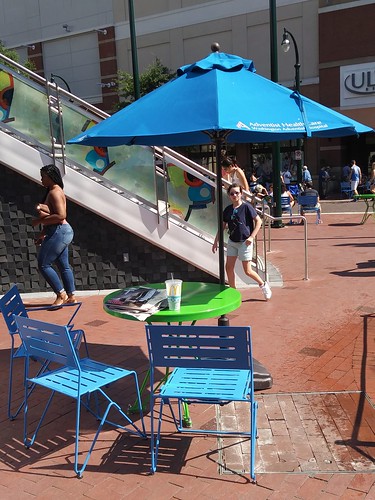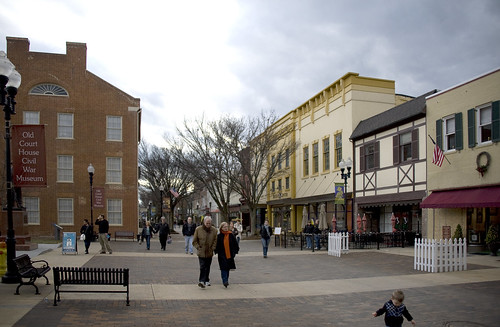Parks and placemaking matters
1. Tactical urbanism/small projects to improve communities. Some time ago, blogreader mattxmal brought to our attention the Curbed special entry, "101 small ways you can improve your city." It's a list of what we might call tactical urbanism interventions. Conveniently, they break up the list into six categories:
- On Your Street
- In Your Neighborhood
- At Your Parks
- Along Your Route
- With Your Neighbors
- In Your Community
-- Tactical Urbanist's Guide to Materials and Design v.1.0
-- Tactical Urbanism v. 2
other great resources for community-initiated projects include the Open Streets Guide manual on creating "open streets" initiatives--Ciclovias and a set of publications on doing projects in public parks by the Toronto organization Park People:
-- Park Friends Group Guidebook
-- Adopt-a-Park-Tree-Manual
-- How-to Host a Campfire in the Park
-- How-to Host a Movie in the Park
-- How-to Host a Picnic in the Park
-- How-to Connect with Nature in the Park
There is even a Tactical Urbanism Guidebook for Eugene, Oregon. Maybe more communities to produce similar guides, to encourage innovation and streamline the approvals process.
2. AmericaWalks microgrant program. Appropro of the Curbed listing, AmericaWalks has announced the third round of their "community change micro grants" program, for projects that improve the public sphere for walking and "making walking more commonplace." According to the website:
This program awards up to $1,500 to fund or help to catalyze smaller-scale, low-cost projects and programs that increase the prevalence of walking, expand the diversity of people and organizations working to advance walkability, and help to make walking safer, easier, and more fun for all community members.-- 2015 Grant Awardees
-- 2016 Grant Awardees
Many communities have small grants programs. I am impressed with Pittsburgh's Sprout Fund while DC's Awesome Foundation does something similar. A couple decades ago, Savannah had a small grant program for neighborhood block-based initiatives which was written about in the ABCD Institute publication City-Sponsored Community Building: Savannah's Grants for Blocks Story.
3. Guide to creating successful farmers markets. Blogreader Nigel calls our attention to a new publication produced by the Project for Public Spaces and the National Main Street, Making Your Market a Dynamic Community Place, for commercial district revitalization programs utilizing farmers (and other types of) markets as an activation device.
(Also see the past blog entry, "The reason(s) why a farmers market is created shapes the type and mix of vendors allowed to sell," and this entry, "Ingredients of a successful farmers market," from the now defunct NeighborhoodNotes blog of Portland, Oregon.)
4. Rich-celebrity park initiative in New York City falls in the face of public opposition. The New York Times reported, "Billionaire Diller's Plan for Elaborate Pier in the Hudson is Dead," that the proposal by Barry Diller to rebuild a pier in the Hudson River was withdrawn in the face of public opposition.
It's a multi-faceted lesson. Plenty of rich person initiated park initiatives have come to fruition, to name one, Klyde-Warren Park in Dallas.
I think the major lesson is that public facilities need to be planned and developed through public processes. It takes a lot longer, but it's much easier, over time, to move forward.
Relatedly, while it's been more than a year, the Garden Bridge Park project in London was scuttled, over similar kinds of issues: lack of a public process and difficulties in raising money ("London garden bridge project collapses in acrimony after £37m spent," Guardian).
 Movable chairs (with tables affixed) have been added to Ellsworth Avenue in Downtown Silver Spring
Movable chairs (with tables affixed) have been added to Ellsworth Avenue in Downtown Silver Spring5. The problem with community-initiated projects is that governments and regulatory processes aren't set up to foster innovation and self-help. Edward Keenan, a columnist for the Toronto Star, has a piece, "Booze, benches, bathrooms; a simple plan to elevate Toronto’s parks," about planning for Toronto's parks and a proposal to allow beer consumption.
Given the reality that all local governments face reduced resources, I think that more communities need to think about how to engage community residents as participants and initiators with various public programs for parks, libraries, community centers, and related facilities.
Keenan discusses a proposal to allow beer consumption (the Philadelphia Horticultural Society runs beer gardens, and beer gardens are being added to park spaces across the country), the need for movable chairs and tables, restrooms and clean restrooms, and the need to dial down the tendency for the city government to be heavy-handed.
Of course I do understand the need to keep alcohol consumption controlled--there's a thin line between making parks "more fun" and nuisance-related inebriation.
An Essen playground.
6. Adding playgrounds to commercial districts as a standard practice. A few years ago when I was in Essen, Germany I was surprised to see a couple of playgrounds within the "central business and shopping district."
This district was the first pedestrianized downtown in Germany, and unlike the mixed use development trend within the U.S., for the most part it doesn't include housing.
Lack of housing turns out to be a good thing, because it makes it easier to get approvals for music festivals and night-time events which would be harder to achieve if housing was interspersed throughout the district.
A couple months ago I was walking with a parent (his kids were away) along the pedestrian mall in Downtown Winchester, Virginia, and he made the point that because the district doesn't have a playground, it would be hard to keep his rambunctious boys "content" were his family with us.

As more families live in cities, we need to be more accommodating of children and their need to expend energy--especially if we want to retain families. In the short term, adding playgrounds will also help families stay longer (and spend more money) in commercial districts.
Something else demonstrated by playgrounds in Germany was the attention paid to quality construction.
A stainless steel swingset in Downtown Essen.
The playgrounds I saw used equipment constructed out of stainless steel. It cost more sure, but also lasts much longer.
7. Splash fountains and downtowns. Splash fountains tend to be a feature added to plazas and commercial areas, but separate from playgrounds. Access tends to be limited to children. Why shouldn't adults be allowed to wet themselves down in a splash fountain too?
Photo of the Downtown Winchester splash pad from Trover.
And like playgrounds, splash fountains need to be added to more places. Ironically, Downtown Winchester has one, but not a playground. The same is true of Downtown Silver Spring--no playground but a splash fountain. I think Downtown DC has neither a splash fountain nor a playground. Etc.
In my first training in the Main Street commercial district revitalization approach, one of the case studies was of Downtown Springfield, Illinois and the various events there, and their realization that they needed to drop "children-focused" events because that wasn't their "positioning."
Now, I think that we need to be a bit more flexible and make public spaces and districts more accommodating and less proscriptive. Adding playgrounds and splash pads help to do this.
Note that in my recent series of pieces on Silver Spring, I missed the need to add a playground to the mix as a distinct element of the program ("Part 2: Program items 1- 9" and "Part 3: Program items 10-18"). A splash park isn't enough.
8. Many DC artificial turf fields don't have enough "give." The Northwest Current reports, "City creates working group after 16 public fields fail safety test," that the safety inspection process for artificial turf fields was flawed, and almost one-third of the fields are "insufficiently absorbent, increasing the risk of injury to players." This is further discussed in an editorial, "Lack of transparency worsens field closure debacle."
9. DC proposes to cut back the hours of the Chevy Chase Community Center: most DC recreation facilities close at 9 pm. The Current also reports on a matter in the Chevy Chase neighborhood, "Chevy Chase neighbors resist plan to cut community center’s hours." The community center there is unusual in two respects. First, it is well located--it abuts the commercial district, so it is centrally located in a manner that is atypical of the distribution of such facilities across the city.
It is further unusual in that its closing time during the week is 10 pm, when most city buildings serving the public in this kind of fashion close at 9 pm or earlier. I haven't looked up the hours for all the city's rec/community centers, but I looked up 7 other facilities located in the NW, NE, and SE quadrants and none stay open later than 9pm.
It looks like the Department of Parks and Recreation wants to swat down Chevy Chase as the exception to the rule.
By contrast, I'd argue that more recreation and community facilities should be open later, just as how over the past few years the DC Public Library system has expanded and extended its hours, with most libraries open til 9 pm many nights of the week and on Sundays til 6 pm.
Note that most recreation centers in Montgomery County Maryland stay open til 9:30 pm while the facilities in Arlington County and Fairfax County Virginia stay open til 10 pm.
10. Library hours can be extended as well. Also in Montgomery County in the summer, some of the libraries located in commercial districts like Silver Spring stay open til 9 pm on Friday and Saturday, whereas in DC, the libraries close at 5:30 pm on both Friday and Saturday.
At the very least, a community's central library should be open later as well. Montreal's is open til 10 pm Tuesday to Friday. As are most Barnes & Noble bookstores.
Labels: civic assets, cultural planning, parks planning, public realm framework, urban design/placemaking






0 Comments:
Post a Comment
<< Home